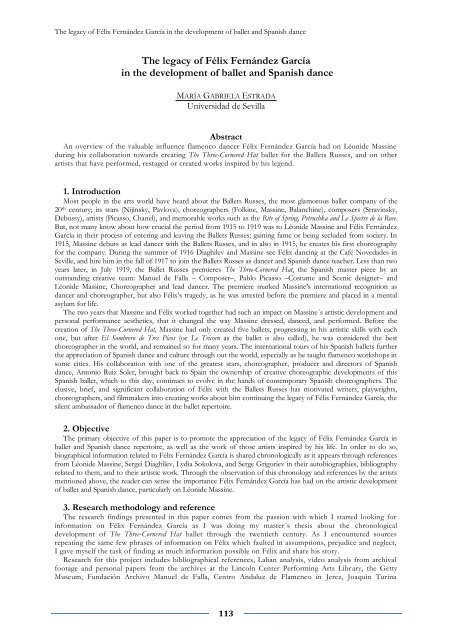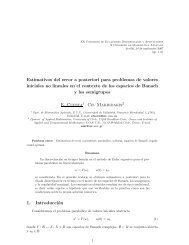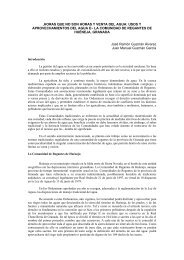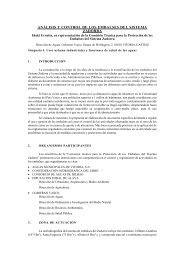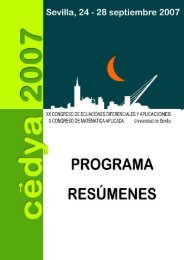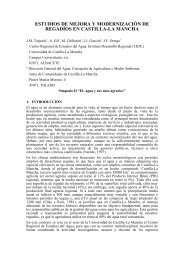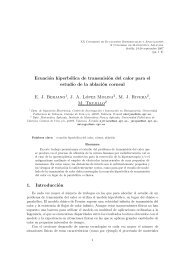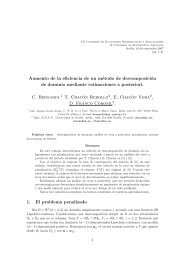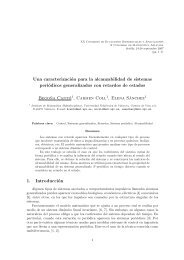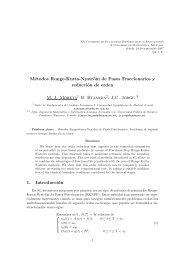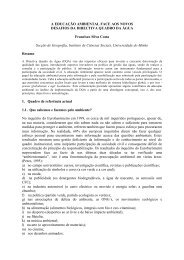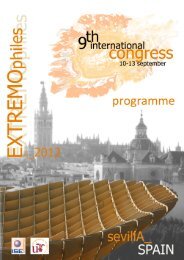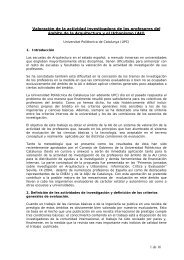LIBRO DE ACTAS (pdf) - Universidad de Sevilla
LIBRO DE ACTAS (pdf) - Universidad de Sevilla
LIBRO DE ACTAS (pdf) - Universidad de Sevilla
Create successful ePaper yourself
Turn your PDF publications into a flip-book with our unique Google optimized e-Paper software.
The legacy of Félix Fernán<strong>de</strong>z García in the <strong>de</strong>velopment of ballet and Spanish dance<br />
The legacy of Félix Fernán<strong>de</strong>z García<br />
in the <strong>de</strong>velopment of ballet and Spanish dance<br />
MARÍA GABRIELA ESTRADA<br />
<strong>Universidad</strong> <strong>de</strong> <strong>Sevilla</strong><br />
Abstract<br />
An overview of the valuable influence flamenco dancer Félix Fernán<strong>de</strong>z García had on Léoni<strong>de</strong> Massine<br />
during his collaboration towards creating The Three-Cornered Hat ballet for the Ballets Russes, and on other<br />
artists that have performed, restaged or created works inspired by his legend.<br />
1. Introduction<br />
Most people in the arts world have heard about the Ballets Russes, the most glamorous ballet company of the<br />
20 th century; its stars (Nijinsky, Pavlova), choreographers (Folkine, Massine, Balanchine), composers (Stravinsky,<br />
Debussy), artists (Picasso, Chanel), and memorable works such as the Rite of Spring, Petrushka and Le Spectre <strong>de</strong> la Rose.<br />
But, not many know about how crucial the period from 1915 to 1919 was to Léoni<strong>de</strong> Massine and Félix Fernán<strong>de</strong>z<br />
García in their process of entering and leaving the Ballets Russes; gaining fame or being seclu<strong>de</strong>d from society. In<br />
1915, Massine <strong>de</strong>buts as lead dancer with the Ballets Russes, and in also in 1915, he creates his first choreography<br />
for the company. During the summer of 1916 Diaghilev and Massine see Félix dancing at the Café Noveda<strong>de</strong>s in<br />
Seville, and hire him in the fall of 1917 to join the Ballets Russes as dancer and Spanish dance teacher. Less than two<br />
years later, in July 1919, the Ballet Russes premieres The Three-Cornered Hat, the Spanish master piece by an<br />
outstanding creative team: Manuel <strong>de</strong> Falla – Composer–, Pablo Picasso –Costume and Scenic <strong>de</strong>signer– and<br />
Léoni<strong>de</strong> Massine, Choreographer and lead dancer. The premiere marked Massine’s international recognition as<br />
dancer and choreographer, but also Félix’s tragedy, as he was arrested before the premiere and placed in a mental<br />
asylum for life.<br />
The two years that Massine and Félix worked together had such an impact on Massine´s artistic <strong>de</strong>velopment and<br />
personal performance aesthetics, that it changed the way Massine dressed, danced, and performed. Before the<br />
creation of The Three-Cornered Hat, Massine had only created five ballets, progressing in his artistic skills with each<br />
one, but after El Sombrero <strong>de</strong> Tres Picos (or Le Tricorn as the ballet is also called), he was consi<strong>de</strong>red the best<br />
choreographer in the world, and remained so for many years. The international tours of his Spanish ballets further<br />
the appreciation of Spanish dance and culture through out the world, especially as he taught flamenco workshops in<br />
some cities. His collaboration with one of the greatest stars, choreographer, producer and directors of Spanish<br />
dance, Antonio Ruiz Soler, brought back to Spain the ownership of creative choreographic <strong>de</strong>velopments of this<br />
Spanish ballet, which to this day, continues to evolve in the hands of contemporary Spanish choreographers. The<br />
elusive, brief, and significant collaboration of Félix with the Ballets Russes has motivated writers, playwrights,<br />
choreographers, and filmmakers into creating works about him continuing the legacy of Félix Fernán<strong>de</strong>z García, the<br />
silent ambassador of flamenco dance in the ballet repertoire.<br />
2. Objective<br />
The primary objective of this paper is to promote the appreciation of the legacy of Félix Fernán<strong>de</strong>z García in<br />
ballet and Spanish dance repertoire, as well as the work of those artists inspired by his life. In or<strong>de</strong>r to do so,<br />
biographical information related to Félix Fernán<strong>de</strong>z García is shared chronologically as it appears through references<br />
from Léoni<strong>de</strong> Massine, Sergei Diaghilev, Lydia Sokolova, and Serge Grigoriev in their autobiographies, bibliography<br />
related to them, and to their artistic work. Through the observation of this chronology and references by the artists<br />
mentioned above, the rea<strong>de</strong>r can sense the importance Félix Fernán<strong>de</strong>z García has had on the artistic <strong>de</strong>velopment<br />
of ballet and Spanish dance, particularly on Léoni<strong>de</strong> Massine.<br />
3. Research methodology and reference<br />
The research findings presented in this paper comes from the passion with which I started looking for<br />
information on Félix Fernán<strong>de</strong>z García as I was doing my master´s thesis about the chronological<br />
<strong>de</strong>velopment of The Three-Cornered Hat ballet through the twentieth century. As I encountered sources<br />
repeating the same few phrases of information on Félix which faulted in assumptions, prejudice and neglect,<br />
I gave myself the task of finding as much information possible on Félix and share his story.<br />
Research for this project inclu<strong>de</strong>s bibliographical references, Laban analysis, vi<strong>de</strong>o analysis from archival<br />
footage and personal papers from the archives at the Lincoln Center Performing Arts Libr ary, the Getty<br />
Museum, Fundación Archivo Manuel <strong>de</strong> Falla, Centro Andaluz <strong>de</strong> Flamenco in Jerez, Joaquin Turina<br />
113


